Parsers
Question 1 |
S1:Every SLR(1) grammar is unambiguous but there are certain unambiguous grammars that are not SLR(1).
S2: For any context-free grammar, there is a parser that takes at most O(n3 )
Which one of the following options is correct?
S1is true and S2is true
| |
S1is true and S2is false | |
S1is false and S2is true | |
S1is false and S2is false |
Every unambiguous grammar need not be SLR(1). As we know some unambiguous grammar which is CLR(1) but not SLR(1). So S1 is true.
Any CFG (which is in CNF form) can be parsed by CYK algorithm in O(n3) where n is length of string. Although it is not given that CFG is in CNF form but since we can convert any CFG in CNF form so S2 is true
Question 2 |
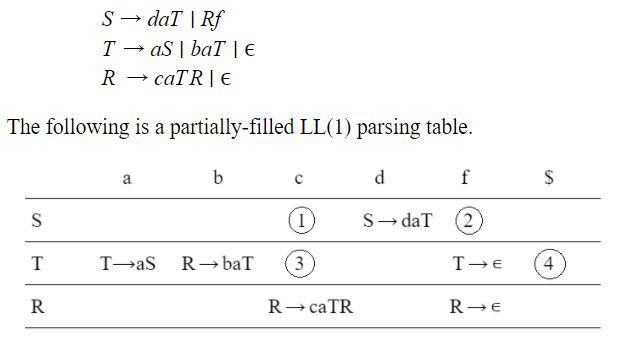
Which one of the following choices represents the correct combination for the numbered cells in the parsing table (“blank” denotes that the corresponding cell is empty)?
① S ⟶ Rf ② S ⟶ Rf ③ T ⟶ ∊ ④ T ⟶ ∊
| |
① blank ② S ⟶ Rf ③ T ⟶ ∊ ④ T ⟶ ∊ | |
① S ⟶ Rf ② blank ③ blank ④ T ⟶ ∊ | |
① blank ② S ⟶ Rf ③ blank ④ blank |
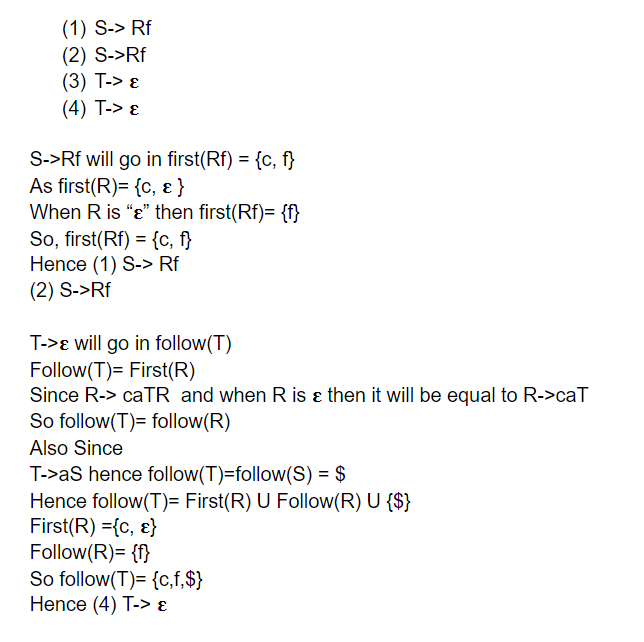
Question 3 |
A shift reduce parser carries out the actions specified within braces immediately after reducing with the corresponding rule of grammar
S → xxW {print "1"}
S → y {print "2"}
W → Sz {print "3"}
What is the translation of xxxxyzz using the syntax directed translation scheme described by the above rules?
23131 | |
11233 | |
11231 | |
33211 |

⇒ 23131
Note SR is bottom up parser.
Question 4 |
Consider the following grammar.
S → aSB|d
B → b
The number of reduction steps taken by a bottom-up parser while accepting the string aaadbbb is _______.
7 |

7 reductions total.
Question 5 |
For the grammar below, a partial LL(1) parsing table is also presented along with the grammar. Entries that need to be filled are indicated as E1, E2, and E3. ε is the empty string, $ indicates end of input, and, | separates alternate right hand sides of productions.
S → aAbB | bAaB | ε A → S B → S

The FIRST and FOLLOW sets for the non-terminals A and B are
FIRST(A) = {a,b,ε} = FIRST(B) FOLLOW(A) = {a,b} FOLLOW(B) = {a,b,$} | |
FIRST(A) = {a,b,$} FIRST(B) = {a,b,ε} FOLLOW(A) = {a,b} FOLLOW(B) = {$} | |
FIRST(A) = {a,b,ε} = FIRST(B) FOLLOW(A) = {a,b} FOLLOW(B) = ∅ | |
FIRST(A) = {a,b} = FIRST(B) FOLLOW(A) = {a,b} FOLLOW(B) = {a,b} |
FOLLOW(P): is the set of terminals that can appear immediately to the right of P in some sentential form.
FIRST(A) = FIRST (S)
FIRST (S) = FIRST (aAbB) and FIRST (bAaB) and FIRST (ϵ)
FIRST(S) = {a, b, ϵ}
FIRST (B) = FIRST (S) = {a, b, ϵ} = FIRST (A)
FOLLOW(A) = {b} // because of production S→a A b B
FOLLOW(A) = {a} // because of production S→ b A a B
So FOLLOW (A) = {a, b}
FOLLOW (B) = FOLLOW (S) // because of production S→ a A b B
FOLLOW (S) = FOLLOW (A) // because of production S → A
So FOLLOW (S) = {$, a, b} = FOLLOW(B)
Question 6 |
For the grammar below, a partial LL(1) parsing table is also presented along with the grammar. Entries that need to be filled are indicated as E1, E2, and E3. ε is the empty string, $ indicates end of input, and, | separates alternate right hand sides of productions.
S → aAbB | bAaB | ε A → S B → S

The appropriate entries for E1, E2, and E3 are
E1: S → aAbB,A → S E2: S → bAaB,B→S E3: B → S | |
E1: S → aAbB,S→ ε E2: S → bAaB,S → ε E3: S → ε | |
E1: S → aAbB,S → ε E2: S → bAaB,S→ε E3: B → S | |
E1: A → S,S →ε E2: B → S,S → ε E3: B →S |
S→ aAbB | bAaB | ε
The production S→ aAbB will go under column FIRST (aAbB) = a, so S→ aAbB will be in E1.
S→ bAaB will go under column FIRST(bAaB) = b, so S→ bAaB will be in E2.
S→ ε will go under FOLLOW (S) = FOLLOW(B) = {a, b, $ } , So S→ ε will go in E1, E2 and under column of $.
So E1 will have: S→ aAbB and S→ ε.
E2 will have S→ bAaB and S→ ε.
Now, B→ S will go under FIRST (S) = {a, b, ε}
Since FIRST(S) = ε so B→ S will go under FOLLOW (B) = {a, b, $}
So E3 will contain B→ S.
Question 7 |
Which of the following statements is true?
SLR parser is more powerful than LALR | |
LALR parser is more powerful than Canonical LR parser | |
Canonical LR parser is more powerful than LALR parser | |
The parsers SLR, Canonical CR, and LALR have the same power |
Canonical LR parser is more powerful than LALR parser.
Question 8 |
Which of the following is the most powerful parsing method?
LL (1) | |
Canonical LR | |
SLR | |
LALR |
LR > LALR > SLR
Question 9 |
Which of the following derivations does a top-down parser use while parsing an input string? The input is assumed to be scanned in left to right order.
Leftmost derivation | |
Leftmost derivation traced out in reverse | |
Rightmost derivation | |
Rightmost derivation traced out in reverse |
Bottom-Up parser - Reverse of rightmost derivation
Question 10 |
Which of the following statements is false?
An unambiguous grammar has same leftmost and rightmost derivation | |
An LL(1) parser is a top-down parser | |
LALR is more powerful than SLR | |
An ambiguous grammar can never be LR(k) for any k |
Option C: LALR is more powerful than SLR.
Option D: An ambiguous grammar can never be LR (k) for any k, because LR(k) algorithm aren’t designed to handle ambiguous grammars. It would get stuck into undecidability problem, if employed upon an ambiguous grammar, no matter how large the constant k is.
Question 11 |
Consider the following grammar with terminal alphabet ∑{a,(,),+,*} and start symbol E. The production rules of the grammar are:
E → aA
E → (E)
A → +E
A → *E
A → ε
(a) Compute the FIRST and FOLLOW sets for E and A.
(b) Complete the LL(1) parse table for the grammar.
Theory Explanation is given below. |
Question 12 |
Assume that the SLR parser for a grammar G has n1 states and the LALR parser for G has n2 states. The relationship between n1 and n2 is:
n1 is necessarily less than n2 | |
n1 is necessarily equal to n2
| |
n1 is necessarily greater than n2
| |
None of the above |
Question 13 |
Consider the grammar shown below
S → i E t S S' | a S' → e S | ε E → b
In the predictive parse table. M, of this grammar, the entries M[S', e] and M[S', $] respectively are
{S'→e S} and {S'→ε} | |
{S'→e S} and { } | |
{S'→ε} and {S'→ε} | |
{S'→e S, S'→ε} and {S'→ε} |
First(S') = {e,ε}
First(E) = {b}
Follow(S') = {e,$}
Only when 'First' contains ε, we need to consider FOLLOW for getting the parse table entry.

Hence, option (D) is correct.
Question 14 |
Consider the grammar shown below.
S → C C C → c C | d
The grammar is
LL(1) | |
SLR(1) but not LL(1)
| |
LALR(1) but not SLR(1) | |
LR(1) but not LALR(1)
|
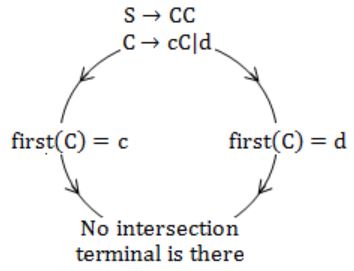
Hence, it is LL(1).
Question 15 |
The go to part of both tables may be different. | |
The shift entries are identical in both tables. | |
The reduce entries in the tables may be different. | |
The error entries in the tables may be different. |
Reduce entry and error entry may be different due to conflicts.
Question 16 |
Choose the correct alternatives (more than one may be correct) and write the corresponding letters only: Indicate all the true statements from the following:
Recursive descent parsing cannot be used for grammar with left recursion. | |
The intermediate form the representing expressions which is best suited for code optimization is the post fix form. | |
A programming language not supporting either recursion or pointer type does not need the support of dynamic memory allocation. | |
Although C does not support call by name parameter passing, the effect can be correctly simulated in C.
| |
No feature of Pascal violates strong typing in Pascal. | |
A and D |
(B) False.
(C) It is false. The language can have dynamic data types which required dynamically growing memory when data type size increases.
(D) Is true and using macro we can do this.
(E) Out of syllabus now.
Question 17 |
S’ ⟶ S
S ⟶ S#cS
S ⟶ SS
S ⟶ S@
S ⟶ < S >
S ⟶ a
S ⟶ b
S ⟶ c
Let I0=CLOSURE({S' ⟶.S}). The number of items in the set GOTO(GOTO(I0, <), <) is ____________.
8 |
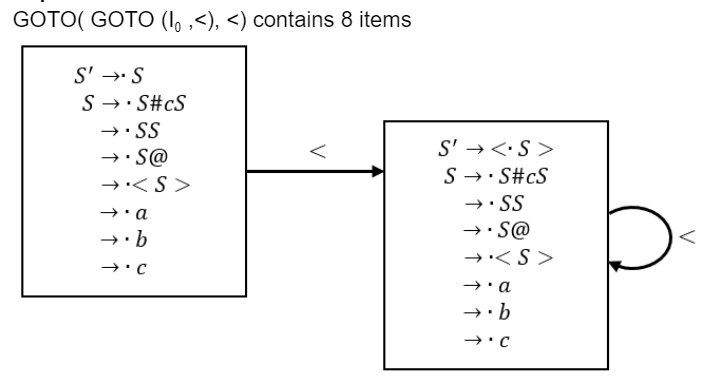
Question 18 |
The LALR (1) parser for a grammar G cannot have reduce-reduce conflict if the LR (1) parser for G does not have reduce-reduce conflict. | |
Symbol table is accessed only during the lexical analysis phase. | |
Data flow analysis is necessary for run-time memory management. | |
LR (1) parsing is sufficient for deterministic context-free languages. |
Symbol table is accessed in all the phases of compiler and not only in lexical analysis phase.
Data flow analysis is done in the control flow graph, in the code optimization phase. If LR(1) parses a grammar then definitely it is DCFL, so LR(1) parsing is sufficient for deterministic context-free languages.
Question 19 |
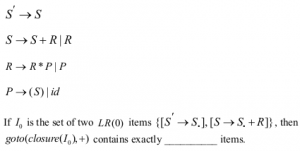
5 |

Question 20 |
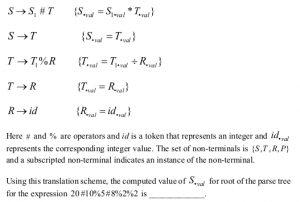
80 |

Question 21 |
An operator precedence parser is a
Bottom-up parser. | |
Top-down parser. | |
Back tracking parser. | |
None of the above. |
Question 22 |
Merging states with a common core may produce __________ conflicts and does not produce ___________ conflicts in an LALR purser.
Reduce-Reduce, Shift-Reduce |
Question 23 |
Which of the following grammar rules violate the requirements of an operator grammar? P,Q,R are nonterminals, and r,s,t are terminals.
- (i) P → Q R
(ii) P → Q s R
(iii) P → ε
(iv) P → Q t R r
(i) only | |
(i) and (iii) only | |
(ii) and (iii) only | |
(iii) and (iv) only |
i) On RHS it contains two adjacent non-terminals.
ii) Have nullable values.
Question 24 |
Which one of the following is True at any valid state in shift-reduce parsing?
Viable prefixes appear only at the bottom of the stack and not inside | |
Viable prefixes appear only at the top of the stack and not inside | |
The stack contains only a set of viable prefixes | |
The stack never contains viable prefixes |
A viable prefixes is prefix of the handle and so can never extend to the right of handle, i.e., top of stack.
So set of viable prefixes is in stack.
Question 25 |
Which of the following statements about parser is/are CORRECT?
I. Canonical LR is more powerful than SLR.
II. SLR is more powerful than LALR.
III. SLR is more powerful than Canonical LR.
I only | |
II only | |
III only | |
II and III only |
The power in increasing order is:
LR(0) < SLR < LALR < CLR
Hence only I is true.
Question 26 |
stmt → if expr then expr else expr; stmt | ȯ
expr → term relop term | term
term → id | number
id → a | b | c
number → [0-9]
where relop is a relational operator (e.g., <, >, …), ȯ refers to the empty statement, and if, then, else are terminals.
Consider a program P following the above grammar containing ten if terminals. The number of control flow paths in P is ________. For example, the program
if e1 then e2 else e3 has 2 control flow paths, e1 → e2 and e1 → e3.
1024 | |
1025 | |
1026 | |
1027 |
if
if
:
:
:
(keep doing 10 times to get 10 'if')
We know that every if statement has 2 control flows as given in question. Hence,
We have 2 control flow choices for 1st 'if'
We have 2 control flow choices for 2nd 'if'
:
:
:
We have 2 control flow choices for 10th 'if'
Since all the choices are in one single structure or combination, so total choices are
2 × 2 × 2 × ........ 10 times = 210 = 1024
Question 27 |
S → Aa
A → BD
B → b | ε
D → d | ε
Let a, b, d and $ be indexed as follows:

Compute the FOLLOW set of the non-terminal B and write the index values for the symbols in the FOLLOW set in the descending order. (For example, if the FOLLOW set is {a, b, d, $}, then the answer should be 3210)
30 | |
31 | |
10 | |
21 |
{Follow(B) = Follow(A) when D is epsilon}
Follow(B) = {d} Union {a} = {a,d}
Hence Answer is : 31
Question 28 |
Which one of the following kinds of derivation is used by LR parsers?
Leftmost in reverse | |
Rightmost in reverse | |
Leftmost | |
Rightmost |
Question 29 |
Consider the augmented grammar given below:
S' → S
S → 〈L〉 | id
L → L,S | S
Let I0 = CLOSURE ({[S' → ·S]}). The number of items in the set GOTO (I0 , 〈 ) is: _____.
4 | |
5 | |
6 | |
7 |

Hence, the set GOTO (I0 , 〈 ) has 5 items.
